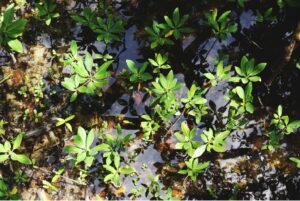World Mangrove Day
By Dina Constantinides
Did you know that there is an entire day dedicated to Mangroves? July 26th is known as International Day for the Conservation of the Mangrove Ecosystem (World Mangrove Day for short) adopted by the General Conference of UNESCO in 2015. The purpose of this holiday is to spread information and raise awareness about the importance of these beautiful ecosystems and how to better protect them.

What are Mangroves?
Mangroves are a large group of evergreen trees and shrubs that are located in the coastal intertidal zone in tropical and subtropical zones. The term mangrove refers to both the actual trees/shrubs as well as their ecosystems. Mangroves are known to exist in brackish, poorly oxygenated waters where most vegetation cannot survive. However, they are able to thrive in these kinds of environments due to a series of unique adaptations. For example, stilt or prop roots that stick out of the water stabilize them within fluctuating water levels and allow the plants to absorb oxygen from the air when they can’t access it in the water. In red mangroves, complex filtration systems keep out excess salt, while black and white mangroves are able to excrete salt in small crystals on their leaves.
Why are mangroves ecologically important? Why should we care?
Mangroves are not only fascinating in themselves, but also play an extremely important ecological role as they provide habitat for a diverse array species of fish, crustaceans, mollusks, birds, etc. as they feed and reproduce. They also provide a variety of crucial ecosystem services, including: providing habitat and breeding grounds for fish and other wildlife, sequestering large amounts of below ground carbon, trapping sediment to help build soil and protect from erosion, and providing protection from flood waves, wind, and storm surges. Although mangrove forests are only a small percentage of the world’s forests, they store the most carbon underground compared to any other type of forest! Mangroves also help keep water clean and pristine through filtering pollutants and sediments- think of the crystal clear waters of the Yucatan Peninsula- this wouldn’t be possible without mangrove forests working hard behind the scenes!
Mangrove forests are of extreme economic importance to coastal communities as well, especially those with economies based around activities such as fishing. It is estimated that a shocking 75% of all tropical commercial fish and their ecosystems are reliant on mangrove forests (Alexandris, 2014). Most heavily affected by the destruction of mangrove systems are low-income, coastal communities. In some cases, mangroves are essential to surrounding areas as they provide wood for construction, medicine, dyes and cooking fuel. Mangrove forests are also of cultural significance to many coastal communities and are often cherished by indigenous populations.
In what ways are mangroves being threatened?
Despite their natural beauty and ecological importance, mangrove forests are severely threatened by anthropogenic environmental degradation. It is estimated that 25% of mangroves in Brazil have been destroyed since the beginning of the 20th century (Schaeffer-Novelli, 2018) and 35% of mangroves worldwide have disappeared just in the last two decades (Alexandris, 2014). Due to the location of mangrove ecosystems at the interface between waterways and land, they are vulnerable to a multitude of threats and act as a sink for all kinds of pollutants. One of the main threats facing mangroves is deforestation and land conversion for things like infrastructure and tourism. Another major cause of their decline is shrimp aquaculture, which is growing rapidly in Southeast Asia and Latin America. Large areas of mangrove forests are being destroyed to create ponds for shrimp farming, accounting for 20-50% of converted mangrove area (Kaffman et al, 2018). Pollution of waterways and changes in soil biochemistry can also be a major threat to mangroves, which is often as a result of nearby shrimp ponds or poor sewage systems.
Climate change is arguably at the root of the main threats facing mangrove forests going forward. Increasing temperatures, sea level rise, and more frequent severe climatic events such as fires and floods all pose serious threats to these precious ecosystems.
What can be done to help?
Luckily, the restoration of mangroves is typically very rapid compared to other kinds of forests and organizations around the world are working hard to try and mitigate the effects of climate change and anthropogenic destruction of mangrove forests through restoration projects. For example, here in Itacaré, we are working to replant white mangroves along the “Rio de Contas” where freshwater meets saltwater, an area that was previously destroyed for construction. The goals of this restoration project are to engage the local community and youth in an effort to restore some of the natural ecosystem and emphasize the importance of these ecosystems in providing a multitude of services to the city of Itacaré. Through an angle of citizen science, we hope to provide an opportunity for environmental education and connection with the natural beauty in Itacaré, creating a base of citizens who are passionate about protecting natural ecosystems.
Typically, the most effective strategy for the replanting of mangrove forests is to directly plant tree propagules as opposed to planting seeds. Several factors can affect the success or failure of restoration projects, including but not limited to: the occurrence and extent of anthropogenic activities, characteristics of the site (soil type, topography, pH, wave energy), and whether or not a monitoring plan is in place to keep track of the success of the project (Kissoon).
Fortunately, many of the mangrove propagules we planted here in Itacaré have developed and we hope to continue to succeed in our efforts! For this reason, we are currently working on developing a citizen-science friendly monitoring plan to be able to track the progress of tree growth and determine what factors may be influencing the success or failure of the project.
Sources:
Alexandris, N., Chatenoux, B., Lopez Torres, L., and Peduzzi, P. (2013): Monitoring mangrove restoration from space, UNEP/GRID-Genev
Da Silva Passareli, L. (2013, June). Manguezais Sob uma Perspectiva Social e Econômica: Percepção Ambiental e Valoração do Manguezal do Estuário do Rio Paraíba do Sul, Rio de Janeiro [PDF]. Campos dos Goytacazes: Universidade Estadual do Norte Fluminense Darcy Ribeiro.
Kauffman, J. B., Bernardino, A. F., Ferreira, T. O., Bolton, N. W., Gomes, L. E., & Nobrega, G. N. (2018). Shrimp ponds lead to massive loss of soil carbon and greenhouse gas emissions in northeastern BRAZILIAN MANGROVES. Ecology and Evolution, 8(11), 5530-5540. doi:10.1002/ece3.4079
Kissoon, I. (n.d.). GMRP Mangrove Restoration Monitoring Plan [PDF].
Schaeffer-Novelli, Y. (2018). Mangue e Manguezal. In 1437027619 1043576482 M. Antonio Gonçalves (Ed.), Atlas dos Mangeuzais. Brasília, Distrito Federal: Instituto Chico Mendes de Conservação da Biodiversidadede.
Tropical Research and Conservation Center. (n.d.). Niger Delta Citizen Science Project [PDF].
US Department of Commerce, N. (2009, June 03). What is a mangrove forest? Retrieved July 23, 2021, from https://oceanservice.noaa.gov/facts/mangroves.html#:~:text=Mangroves%20are%20a%20group%20of,in%20the%20coastal%20intertidal%20zone.&text=There%20are%20about%2080%20different,allow%20fine%20sediments%20to%20accumulate.
-
Interning with ETIV’s new IT Program
My experience combining my interest in data science and cultural immersion as an intern at ETIV.
-
Environmental Education at ETIV
How ETIV environmental education program is helping students connect with nature and learn how to protect their environment.
-
A Rainy Day in Itacaré
An ETIV volunteer’s routine and reflections on a rainy day in Itacaré
-
My Volunteer Routine
My daily routine as a volunteer at ETIV
-
Beach Camping around Itacaré
Beach Camping around Itacaré There’s nothing quite like sleeping under%rarebiz-readmore%
-
The Lost Cachoeira: Part 1
The Lost Cachoeira: Part 1 A little throwback to 2019,%rarebiz-readmore%
